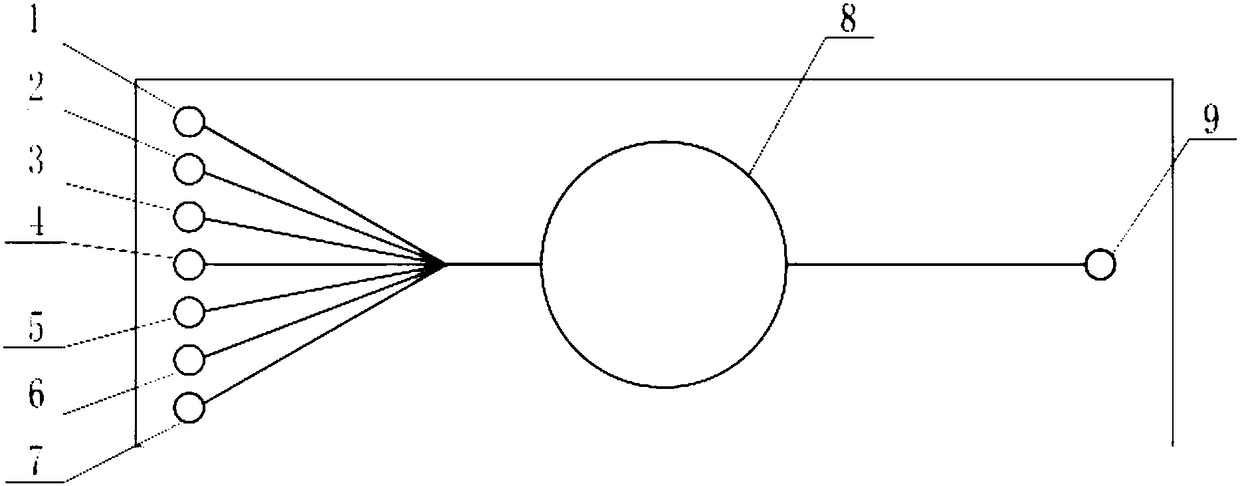Microfluidic chip for detecting microcystins in water and detection method
A microcystin and microfluidic chip technology, applied in the direction of analytical materials, instruments, etc., can solve the problems of limited routine monitoring times, complicated preparation process, high detection cost, etc., and achieve fast detection speed, simple operation and high degree of automation Effect
- Summary
- Abstract
- Description
- Claims
- Application Information
AI Technical Summary
Problems solved by technology
Method used
Image
Examples
Embodiment 1
[0035] Embodiment 1 (preparation of microfluidic chip)
[0036] The glass substrate was sequentially treated with concentrated sulfuric acid, a mixed solution of isopropanol and acetone (1:1) and ethanol, rinsed with deionized water, blown dry with a nitrogen gun, and removed the remaining water in an oven. Coat a layer of Cr on the surface of the glass substrate, and evenly cover a layer of photoresist with a gluing machine; spin-coat RZJ-340 positive photoresist on the treated substrate, and bake it on a hot plate to evaporate it. Residual solvent in photoresist. The substrate is subjected to ultraviolet exposure, development and corrosion. Before etching, immerse the glass piece in a chromium etching solution for etching and harden the film to improve the adhesion between the photoresist and the sacrificial layer. The wet etching is carried out at room temperature, and the etching solution contains HF and HNO 3 of etchant. In order to prolong the resistance time of the p...
Embodiment 2
[0038] Embodiment 2 (coupling of microcystin)
[0039] In this example, the microcystin on the surface of the magnetic beads is coupled by coating the original MC-LR-OVA (a conjugate of MC-LR (microcystin-LR) and OVA (ovalbumin)) . The preparation method of MC-LR-OVA comprises the following steps: take EDC (1-(3-dimethylaminopropyl)-3-ethylcarbodiimide) 100mg, and use 10mmol / L PBS solution 2.5ml of pH=7.0 Make it fully dissolved; take 10mg of MC-LR, dissolve it with 2ml deionized water, take 25mg of blood ovalbumin, dissolve it in PBS solution with pH=7.0, 10mmol / L, mix MC-LR solution with ovalbumin solution , add 2ml of EDC solution dropwise under magnetic stirring, stir at room temperature for 1 hour in the dark, then add the remaining EDC solution dropwise, stir at 4°C for 12 hours and let it stand for 10 hours, then fully dialyze it with distilled water for about 48 hours to obtain MC -LR-OVA.
[0040] The prepared MC-LR-OVA is coupled with immunomagnetic beads, and the...
Embodiment 3
[0042] Embodiment 3 (preparation of microcystin antibody)
[0043] The preparation method of microcystin antibody comprises the following steps: (1) dissolving 0.5mg MC-LR in 2mL, 0.1mol / L carbonate buffer solution of pH=9; weighing 170.4mg β-mercaptoethylamine and adding to the above solution , fully shake and shake, 50 ℃ water bath for 1-1.5h. After the reaction is completed, the solution temperature drops to room temperature, and an acetic acid solution equimolar with β-mercaptoethylamine is added to terminate the reaction;
[0044] (2) Dissolve H2N-MC-LR in 3mL 0.01mol / L PBS with pH=7.4, add 500μL of 1.25% glutaraldehyde solution, and shake vigorously in the dark for more than 3h; according to BSA: H2N-et-MC-LR =10:1 Add 0.5mL of 10mg / mL BSA, shake and mix thoroughly, and shake overnight at 4°C to complete the reaction; filter with an ultrafiltration tube with a molecular weight of 30,000Da, the supernatant solution is the prepared complete antigen, and the conjugated Th...
PUM
 Login to View More
Login to View More Abstract
Description
Claims
Application Information
 Login to View More
Login to View More - R&D Engineer
- R&D Manager
- IP Professional
- Industry Leading Data Capabilities
- Powerful AI technology
- Patent DNA Extraction
Browse by: Latest US Patents, China's latest patents, Technical Efficacy Thesaurus, Application Domain, Technology Topic, Popular Technical Reports.
© 2024 PatSnap. All rights reserved.Legal|Privacy policy|Modern Slavery Act Transparency Statement|Sitemap|About US| Contact US: help@patsnap.com









